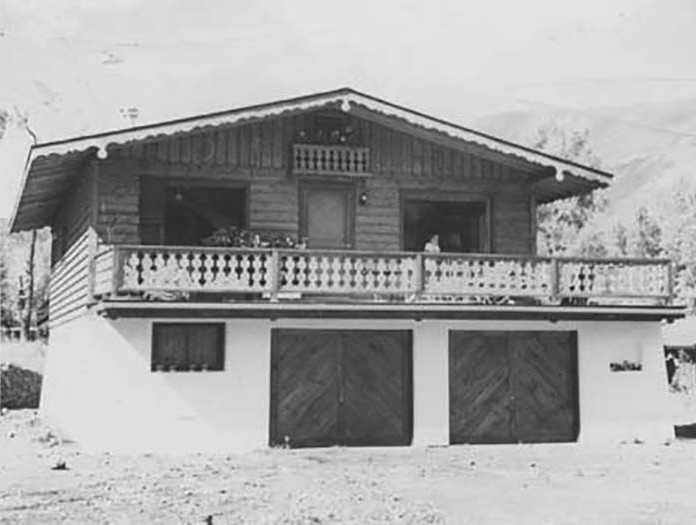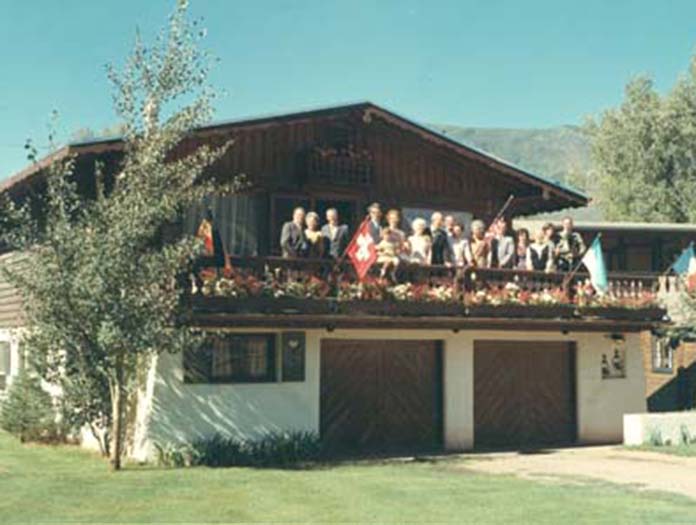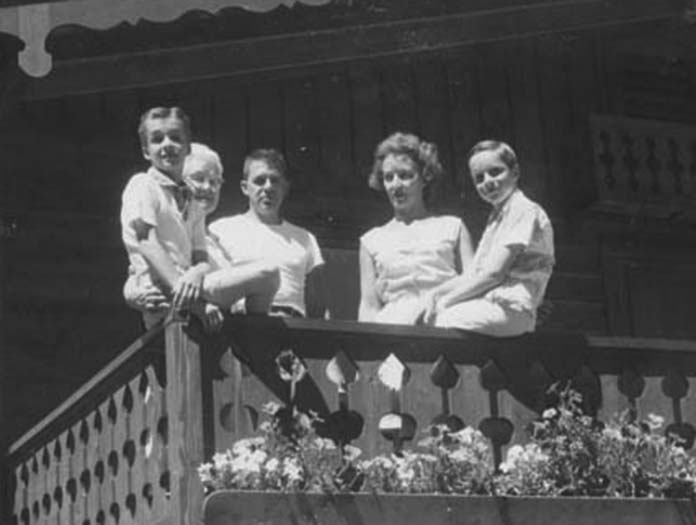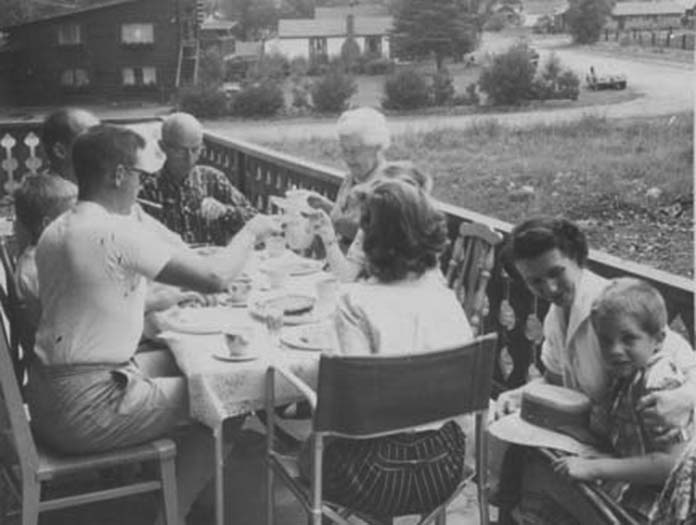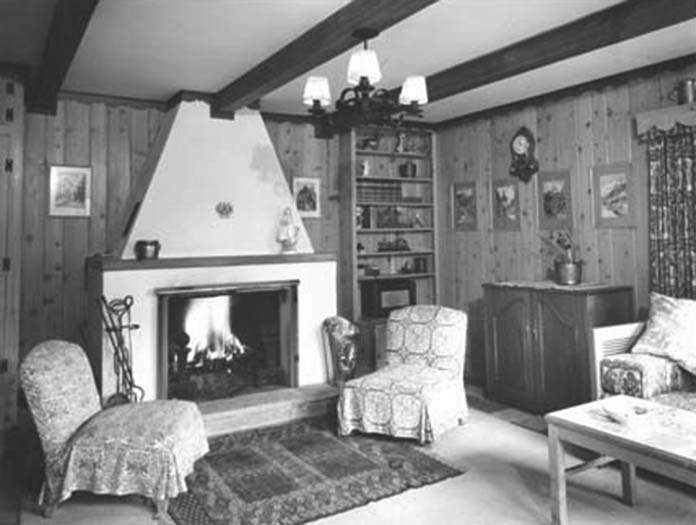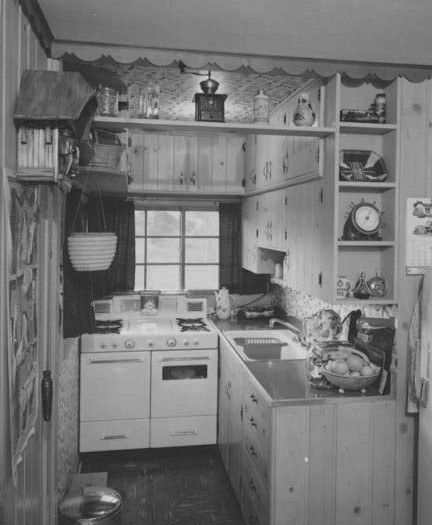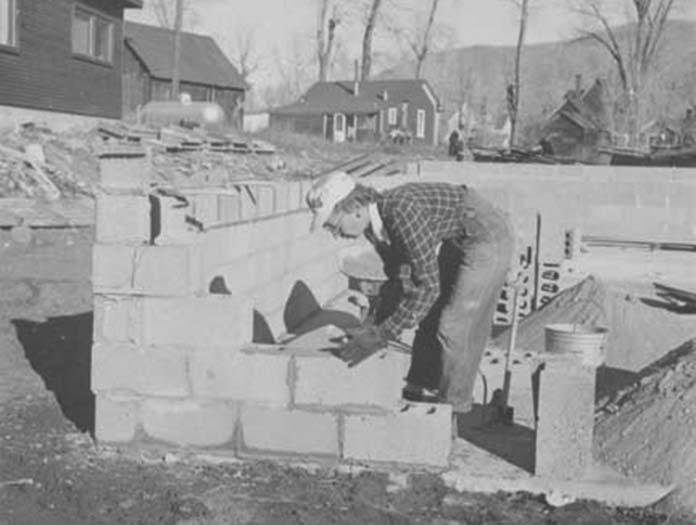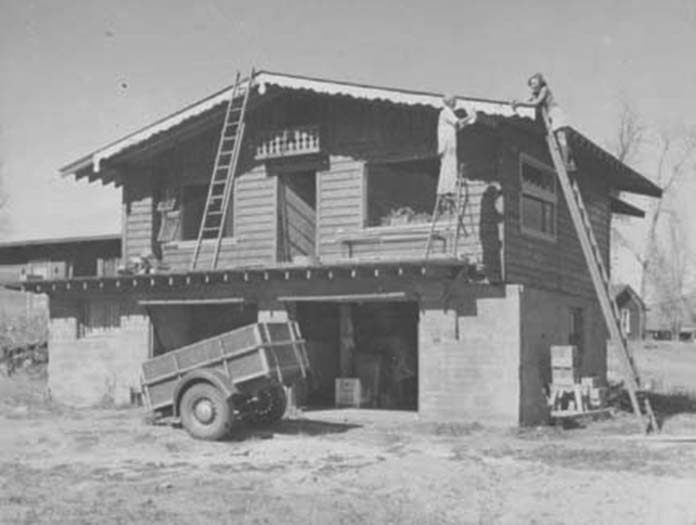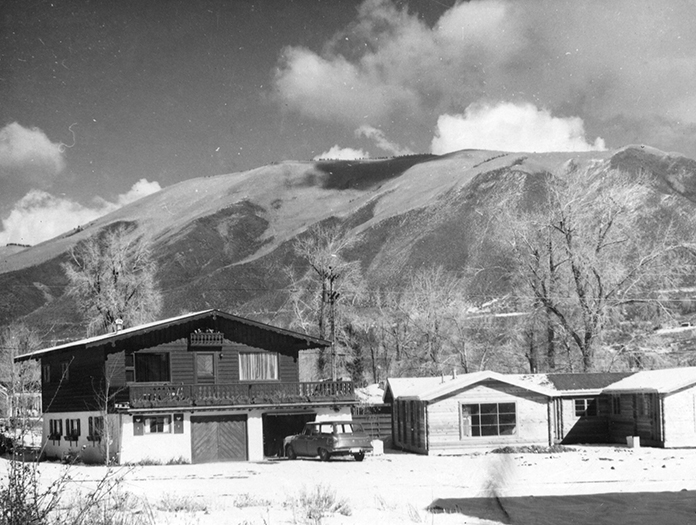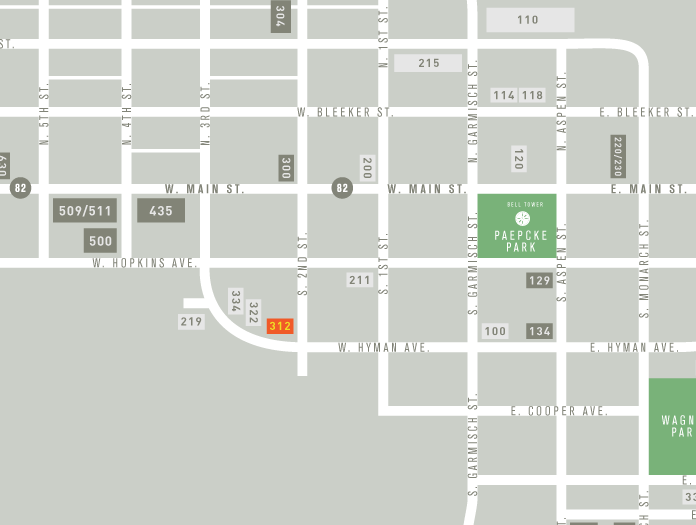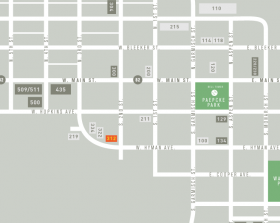312 W Hyman
Construction of the house at 312 W. Hyman began in 1954 and was completed in 1956. Following is a history of how the house came to be built, according to the original owner/builder, Genevieve Birlauf Leininger.
(Submitted by letter to the Aspen Community Development Department, October 2006.)
The house at 312 West Hyman was built by my father and me in 1956. The following is some background on my father and our family and how the house came to be built.
Julius Herman Birlauf was born March 15, 1890 in the city of Basel, Switzerland which is located on the Rhine River where the three countries of Switzerland, France and Germany meet. The house that he was born in was built in about 1325 A.D.
In 1912 my father decided he would go to America and join his relatives in Fort Wayne, Indiana. Meanwhile, my mother and her sister had made plans to leave their home in Babenhausen, Bavaria, and join their brothers who were in Chicago, Illinois. Both my father and mother sailed on the SS Pennsylvania from Hamburg, Germany, and arrived in New York on July 1st. They met during the voyage and, although they parted, each to their destination in the States, they kept in touch and eventually married in Ft. Wayne, Indiana — and it’s there that I was born. This was one shipboard romance that turned out just fine!
It was about this time that my father learned to be a tool-and-die maker. He became sick, at one point, and was advised by his doctor to give up this line of work; (it was thought that the metal filings were damaging his lungs). He was advised by his doctor to move to Colorado where the air and climate, in general, would be better for his health. My mother’s brothers, by this time, were in Estes Park, so my younger brother and I were settled with our parents near our uncles.
Since my uncles worked as waiters in the Lodge, and, since there was no need for tool-and-die makers in Estes Park, my father applied for a position at the same lodge. When he told the interviewer that he was Swiss, it was assumed that he must be a cook, so, they gave him a big chef’s knife and put him to work cutting up the chickens. (Anyway this is the way the story was told to us.) Since the work was seasonal, and jobs were scarce, my father and the rest of us (including my mother’s brothers) eventually moved back to Chicago.
My father had natural-born talent for anything mechanical or for anything that could be made with his own two hands. He was also an expert photographer who developed and processed all his own photographs. My brother and I, by age 12, were in the darkroom learning to process and print our own photographs. During his stints at various upscale hotels and restaurants in and around Chicago (initially as a waiter, and then maitre ‘d), he built (including the cabinets) 8-tube heterodynes and 16-tube superheterodynes (powerful, top-of-the-line types of radios, at the time) which he sold to well-to-do residents living along Lake Michigan, north of Chicago.
In 1937, on the 25th anniversary of my parents’ arrival in this country they, my brother and I, went to Europe to visit grandparents and other family members. At a stop in Ottobeuren, in south Bavaria were relatives who had three daughters. Of course, the girls wanted me to stay, and I wanted to stay. My parents (thinking I would get bored very soon) made me promise that I would stay at least six months. I kept that promise, and, in fact, I stayed and returned in 1940 after having lived in the Black Forest, Basel, Zürich and Paris. Only WWII convinced me it was time to leave — that and the fact that the last passenger ship to leave Europe for the U.S. was leaving on February 14, 1940, from Genoa, Italy.
After a short stint as a member of the aerial photography branch of the U.S. Air Force at Canute Field in Champaign-Urbana, Illiniois, during the beginning of WWII, my brother, Hermi, signed up for Officers Training School in Denver. My parents, wanting to be near him, sold their house in Wilmette, Illinois, and settled in Evergreen, Colorado. Well, as happened to others, he was moved around quite a bit and was finally shipped to the Pacific theater of action. But my parents did not leave Evergreen.
Meanwhile, after the war, I went to work for the government with U.N.R.R.A. (United Nations Relief and Rehabilitation Administration) and sailed to Germany, again, in 1945. While over there, I eventually ended up working for the OMGB (Office of Military Government for Bavaria).
After having read an article about Aspen in Time magazine, in the summer of 1947, while on leave, I traveled to Aspen and bought the west Hyman lot from a Jim (can’t remember his last name) who was one of those people who bought up lots at that time just by paying the back taxes due. I paid $500 for my lot, and, when I went back to my job in Bavaria, I tried to convince all my ski-loving friends to buy in Aspen. Apparently, none of them saw it as a place to live or even to invest in. I was vindicated however when, later on, and it was too late, they admitted that I had been the smart one.
Even my parents didn’t think I was too smart. When my father first saw Aspen he was definitely not impressed. We walked into the lobby of the Hotel Jerome for a look-around. Hanging down from the ceiling on a very long cord was a bare light bulb above the reception desk. That was all the light there was. The only place to eat was the White Kitchen or the Red Onion. I remember my father saying he wouldn’t want to be “caught dead in such a place.” Well, all that changed by the time I came home from Germany in 1954.
After my return to the U.S., I came to Colorado and settled in with my parents in Evergreen. Some time later, I started working through Manpower as temporary office help. It was great for me because I could work a week, then take a week off for skiing in Aspen, then go back and renew the procedure. It worked out fine for me and, for a while, I became what was known as a “ski bum.”
Then, one day while I was pausing on the ski slope, a tall body whizzed by me and with that shape, all in black, I knew it had to be Pat (Costello) Moore. I caught up with her and we got reacquainted. We had met in Munich where we both worked in Military Government for Bavaria (General George Patton’s 3rd Army Headquarters.) She told me that Sara and Army Armstrong (whom we both knew from Germany) had a restaurant called the Copper Kettle on West Hopkins Street in a little Victorian house; (at the time, they could seat about 20 people (if that many) downstairs and maybe 12 or 15 upstairs). And that’s the way the Copper Kettle got started. Pat told me to bring my dirndl (a dress and apron native to Bavaria) and she would put me to work with her — waitressing.
During my travels to Europe before the after the war, I had been inspired by the chalet-style houses I had seen during my travels in Bavaria, the Black Forest in Germany, in Austria (the Tyrol), in northern Italy and Switzerland. Each had its own style depending upon in which country or state it was built in.
With regard to the West Hyman lot, I had thought, initially, about building, a small Bavarian-style hotel for skiers. I don’t remember when I dropped that idea in favor of a single house. In any event, my father and I began building my house in the chalet-style in the summer of 1954.
This worked out just fine for me because the Copper Kettle was open only for dinner. I could report for duty as “salad preparer” in the afternoon and could work on the house with my father in the mornings and on Mondays when the Kettle was closed. We got a lot done on the house that first summer.
There were no architectural drawings for the house. Once we had the foundation poured, we just “put it together” as it came along. I knew what I wanted and that’s what we accomplished. We built to fit the space (as it were). Whatever creative work I did I could not have done without my father and what he taught me. I think we were a good team. Needless to say, after having done extensive remodeling on our house in Wilmette, Illinois, and the house in Evergreen (as well as building a small chalet), by himself, there wasn’t anything my father couldn’t accomplish building-wise. After he completed all the plumbing and electrical work, the house was finished in 1956.
Having met my husband during the previous ski season, we married on Christmas Eve, 1956, and moved to Cambridge, Massachusetts, where he had been attending the Harvard Law School.
My parents had moved into the Aspen house in 1955 as soon as there was a viable roof on the first floor. After the house was completed, they moved upstairs and the downstairs apartment was rented out, over the years, to various renters, some of whom are still living in Aspen (including Gerhard Mayritsch and his wife Elsbeth who rented the downstairs apartment when they first came to Aspen).
From that point on, as residents of Aspen, my parents became an integral part of the community of “old-timers” (those who had come to Aspen just after the war) and came to be known, around town, as “Ma and Pa B.” Since my father had retired, at this point, he did odd jobs around town for people such as Pat Moore and others who required his carpentry and mechanical talents
One of the things my mother became known for was her Gugelhupfs (a German coffee-cake baked in a Bundt pan). Since she had asked the workers at the post office to save new blocks of stamps for her (which she would send to me for my collection), she would bake two Gugelhupfs every week, one for her and my father and one of which she would take down to the post office for the personnel, there, as thanks. Needless to say, she never had many problems with her mail.
Friends I had known during my government work in Germany as well as friends from back east would always come around as much as for mother’s cooking as for my father’s advice on anything that they were doing or having done with regard to carpentry or building work. Such people included: Sarah and Army Armstrong (who started the Copper Kettle), Gerhard Mayritsch (who, with his business-partner, Helmut, started the Wienerstube), Pat Moore, of course, (who had her gallery downtown), Michael Behrendt (who bought and ran the St. Moritz Lodge for a long time), Kurt and Lottie Bresnitz (who owned a jewelry store downtown for many years), and Walter and Herta Mueller, who they knew from Chicago, many years ago, when Walter first came to America.
Father was also an avid fisherman, and, whenever we would come out to visit during summer vacations, we were always taking trips out to Maroon and Castle Creek to fish for trout. He kept a worm-farm in an old metal cooler on the ground at the back of the house from which we always dutifully filled up our bait-holders. There was nothing quite like fresh trout cooked in butter with a little lemon squeezed on top to make it all worth while.
In December of 1972, my mother, while taking a walk, slipped on the ice, fell and broke her hip. Her hip had to be replaced, and, with the need for extensive rehabilitation, I moved my parents from Aspen to our house in Stanford, California. This, unfortunately, ended their residence of 17 years in Aspen. We lost my father in August of 1974 (at the age of 84), and my mother in 1979 (at the age of 87). Condolences were received from our friends in Aspen who fondly remembered them for their many years there. In 1980, I returned to Aspen and hired a small plane from which I spread some of their ashes over Aspen mountain.


